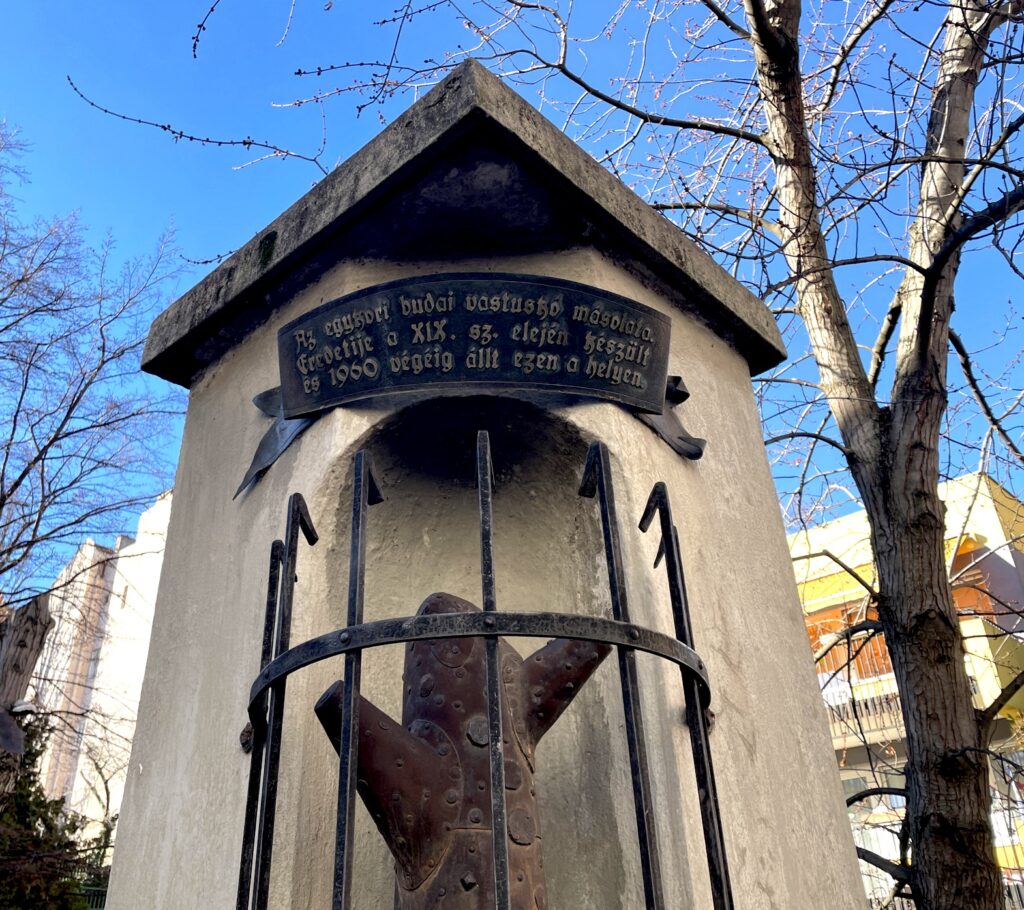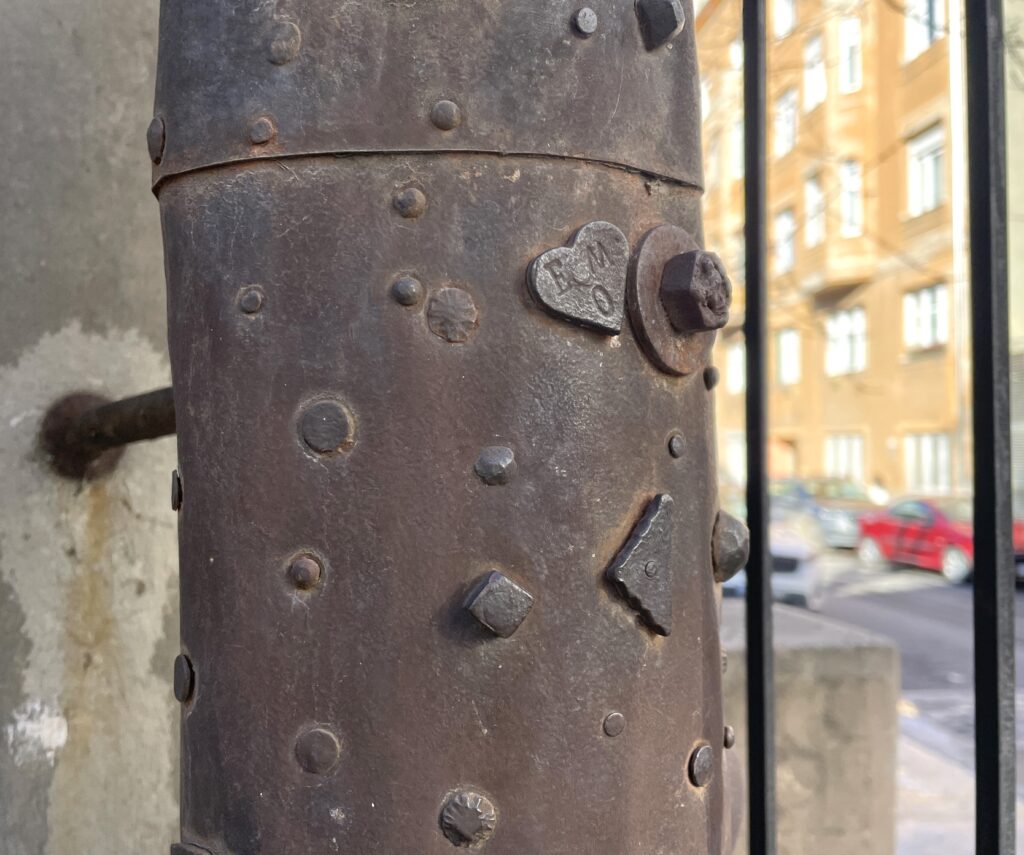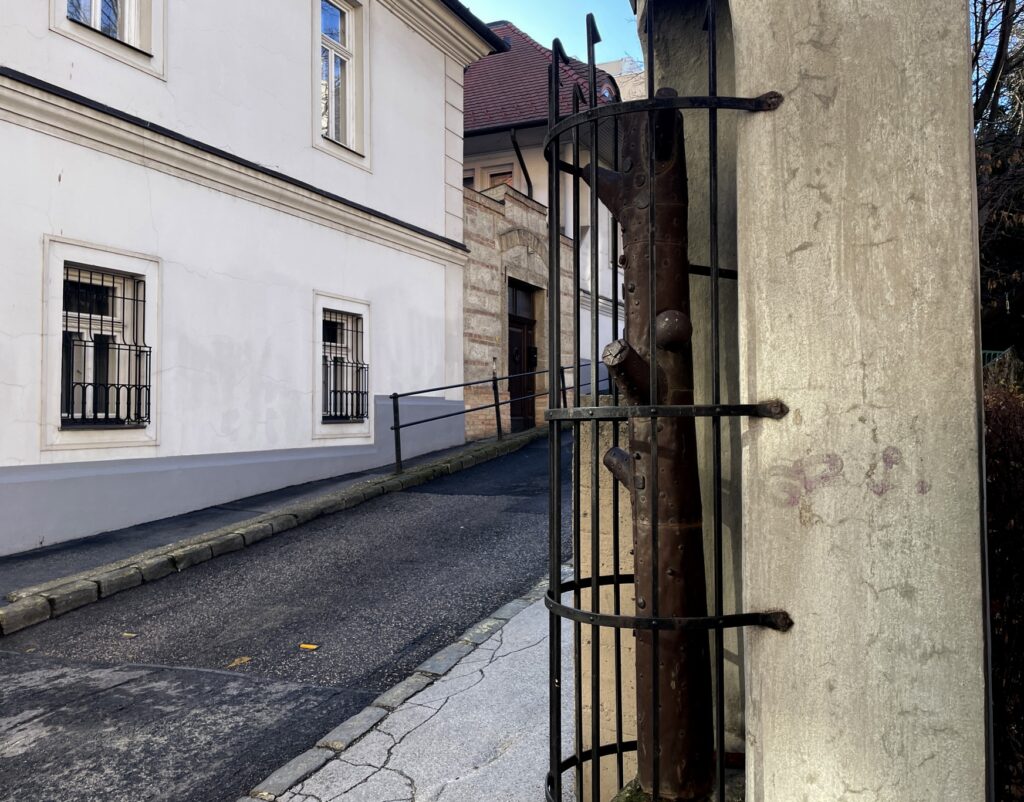Hey, urban adventurers! If you’ve ever roamed Budapest and spotted something odd—a relic that seems out of place yet oddly captivating—you’re not alone. Tucked away in the Víziváros neighborhood, near Batthyány Square, stands one of the city’s strangest sights: the vastuskó, or “iron stump.” This curious hunk of metal, studded with nails, is more than just a forgotten leftover—it’s a portal to a centuries-old tradition of wandering craftsmen wrapped in legends that’ll spark your imagination. I took a detour to check it out and trust me; it’s a hidden gem worth seeking out in 2025!
A Stump Steeped in History
You’ll find the vastuskó at the corner of Iskola Street and Vám Street, nestled into the fence of a local nursery. It’s not the original—that wooden wonder, a 150 cm (5-foot) oak bristling with nails, now lives in the Kiscelli Museum—but a faithful iron replica put up in 1960. Back in the 18th and 19th centuries, this was the real deal: a “nail tree” where journeymen—traveling craftsmen fresh from their apprenticeships—hammered in spikes as they passed through Budapest. It’s a quirky monument to a bygone era, and its story stretches far beyond Hungary.



These nail trees aren’t unique to Budapest. You’ll spot cousins in Győr, Bratislava, and Timișoara, with roots tracing back to German-speaking lands. One of the oldest stands outside Vienna’s Stephansdom, at the Palais Equitable, where nails have been driven into a tree since the 15th century. In Budapest, the tradition took hold on both sides of the Danube—Pest had one at Váci Street and Kis Híd (now Türr István) Street, while Buda’s stood right here in Víziváros. They doubled as signposts too: the Pest stump advertised shops like Ráth Mór’s bookstore, its image stamped on book covers, while the Buda one marked a spice store, clad in tin to protect its weathered wood.
The Nails Tell a Story
Take a close look at the replica—those nails aren’t random. You’ll see squares, triangles, even a heart-shaped one, some etched with initials or names. They’re echoes of the journeymen who left their mark; each spike a token of their travels. Hans Christian Andersen, the fairy-tale maestro, stumbled on Budapest’s vastuskó during his 1841 visit and waxed poetic about it in A Poet’s Bazaar: “In one street stands an iron tree, just like in Vienna, the last memory of the Danube’s ancient forest. Every wandering journeyman drove a nail into it until no space remained, turning it into a tree of iron.” He saw it as a blacksmith’s ritual—nails pounded in for good luck, like coins tossed into a well.
But there’s more to the tale. Local lore, via historian Tóth Béla, ties the Buda stump to coopers (barrel-makers) whose guild once stood nearby. They’d deck it with ribbons on feast days, bless it with a priest, and hammer in monogrammed nails when setting out or returning home. Then there’s the wilder legend: journeymen supposedly tackled a lock on the stump. If they cracked it, they’d win freedom from a curse, cash, or just bragging rights. Most bets are on the curse angle—fittingly, the lock was never actually locked, adding a twist of irony to the challenge.
From Wood to Iron: A Modern Makeover
By 1960, the original Buda vastuskó was showing its age—150 years of nails and weather had taken their toll. Enter the iron stand-in, a sturdy tribute encircled by a grate, preserving the tradition for posterity. The Pest version met a different fate: when its building was reworked, it got hoisted higher on the facade as a quirky sign, but it’s long since vanished. Today, the Kiscelli Museum cradles the Buda original, while the Víziváros replica keeps the legend alive on the street.
Why It’s a Must-See in Víziváros
Víziváros, wedged between the Danube and Buda Castle, is already a treasure trove—think quaint streets, the Batthyány Square market, and that riverside charm. The vastuskó adds a layer of whimsy to the mix. It’s not flashy—no neon signs or tour buses here—just a quiet nod to Budapest’s crafty past. Swing by after a coffee at the square, stroll up Iskola Street and let your eyes linger on those nails. Each one’s a tiny time capsule, a craftsman’s “I was here” etched into history.
Pair it with a wander through the neighborhood—peek at the Capuchin Church or grab a view from the Fisherman’s Bastion nearby. It’s a low-key detour that feels authentically Budapest, far from the touristy bustle of Pest. And if you’re a history geek or just love a good story, this stump’s quirk factor is unbeatable.
A Piece of Budapest’s Soul in 2025
The vastuskó isn’t just a curiosity—it’s a survivor, linking today’s Budapest to a world of wandering artisans and old-school guilds. In a city that’s always evolving (just check out the Várnegyed’s latest facelift!), relics like this remind us of the small, strange threads that weave its fabric. Next time you’re in Víziváros, hunt it down—snap a pic, ponder the legends, and maybe wish for a little luck of your own. What’s the weirdest thing you’ve spotted in Budapest? Drop it below—I’m all about those oddball finds!
Map
Maps Generator